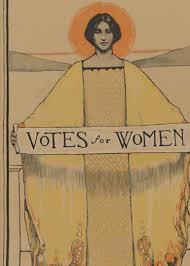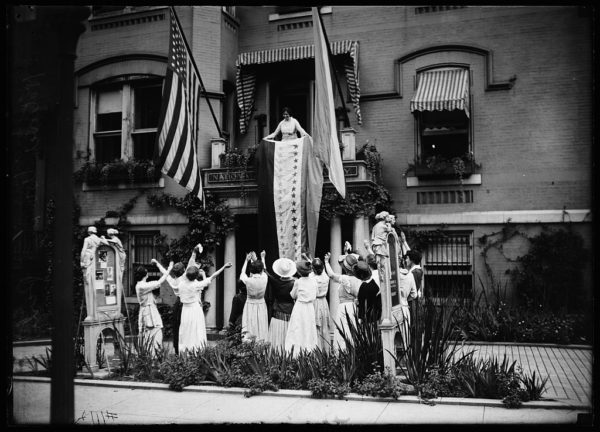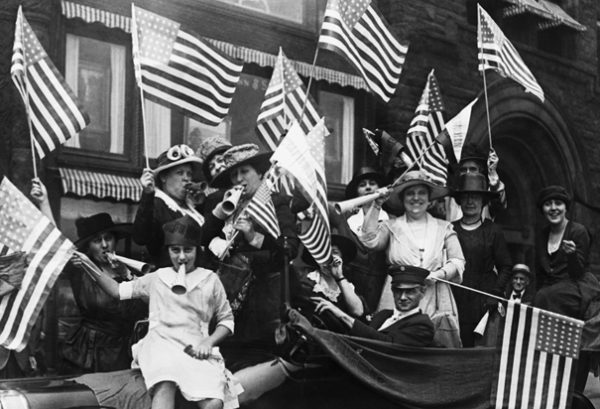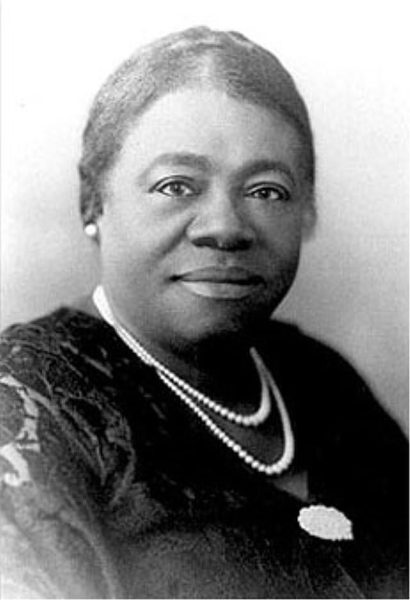Last updated: March 15, 2024
August 26, 2020 was Women’s Equality Day, a celebration of the centennial anniversary of the 1920 ratification of the Nineteenth Amendment to the Constitution that guarantees that, “The right of citizens of the United States to vote shall not be denied or abridged by the United States or by any State on account of sex.” This is part four of a four-part series, describing the many years of exhaustive effort channelled by American women into the suffrage movement that ultimately secured voting rights for women nationally.

In November 1917, there was a referendum held to determine by popular vote whether women in New York – the state with the highest population in the country at the time – would be enfranchised. The proposition passed with significant margin, which caused President Wilson to reconsider his position against women’s suffrage, especially considering how many women had joined the labor force, when the men were needed in combat during WWI. There was still strong opposition for the amendment, particularly in southern states, but the political balance had begun shifting in favor of the women who were calling for suffrage. Nevertheless, the shift at first was subtle, and much effort was still needed to get the amendment approved by both the House and Senate.
The Nineteenth Amendment was brought to the House of Representatives in January 1918, where it passed by a two-thirds majority, but with only one vote to spare. Then, in September 1918, President Wilson made an address on the floor of the Senate, asking the legislators to approve the suffrage amendment as part of the war efforts. He said, “We have made partners of the women in this war; shall we admit them only to a partnership of suffering and sacrifice  and toil and not to a partnership of privilege and right?” However, when it was brought to a vote, the amendment failed to pass, two votes short of the two-thirds majority.
and toil and not to a partnership of privilege and right?” However, when it was brought to a vote, the amendment failed to pass, two votes short of the two-thirds majority.
The women of the National Woman’s Party (NWP) immediately started to campaign against senators who had voted against the amendment. During 1918 and 1919, the House and Senate voted on the Susan B. Anthony Amendment five times. The amendment was voted on again in the Senate on February 10, 1919, where it failed to pass a second time, although this time it lost by only one vote. The amendment continued to fail narrowly in the Senate each time, as Southern Democrats continued to vote against it.
There was considerable interest in trying to get the amendment approved prior to the 1920 presidential election. Suffragists called on President Wilson to convene a special session of Congress to address women’s suffrage. On May 21, 1919, the House of Representatives again passed the 19th Amendment, this time easily, with a margin of 42 votes. And on June 4, 1919, the Southern Democrats abandoned their filibuster in the Senate, and the amendment finally passed with 56 yes votes, 25 no votes, and 14 abstentions. According to The New York Times that day, “Suffragists thronged the Senate galleries in anticipation of the final vote, and when the outcome was announced by President Pro Tem. Cummins, they broke into deafening applause. For two minutes the demonstration went on, Senator Cummins making no effort to check it.” The Silent Sentinels were then finally able to end their picketing of the White House and turn their efforts to the state-by-state ratifications that were needed for formal adoption of the amendment. Carrie Chapman Catt and the National American Woman Suffrage Association (NAWSA) immediately mobilized their members to press the state legislatures to ratify the amendment. Now was the time to sprint to the finish.
 The proposed constitutional amendment required ratification by 3/4 of the states (36 out of 48 at the time) for adoption. Fortunately, millions of women across the country who were advocating for access to the ballot box were well positioned for this effort, because of their many years of grassroots campaigns and activism. Still, ratification of the 19th amendment was not certain. By August 1919, fourteen states had ratified the amendment, and by the end of the year, a total of twenty-two had voted for ratification. In other states, particularly the southern states, support for women’s suffrage proved more difficult to obtain.
The proposed constitutional amendment required ratification by 3/4 of the states (36 out of 48 at the time) for adoption. Fortunately, millions of women across the country who were advocating for access to the ballot box were well positioned for this effort, because of their many years of grassroots campaigns and activism. Still, ratification of the 19th amendment was not certain. By August 1919, fourteen states had ratified the amendment, and by the end of the year, a total of twenty-two had voted for ratification. In other states, particularly the southern states, support for women’s suffrage proved more difficult to obtain.
By the summer of 1920, thirty-five states had ratified the amendment and only one additional state was required for the amendment to be approved. Four states (Connecticult, Vermont, North Carolina and Florida) would not consider ratification and the remaining states had rejected the amendment. Therefore, the culmination of the women’s suffrage effort would be determined in Tennessee, the unlikely final state needed to ratify the 19th amendment.
 Both suffragists and those opposed to women’s suffrage gathered in Nashville and lobbied the legislators in what was later nicknamed the War of the Roses. Suffrage supporters wore yellow roses, while the anti-suffragists wore red roses and the votes were too close to call. The single deciding vote was cast on on August 18, 1920 by 24-year old Harry Burn, who arrived wearing a red rose. He had intended to vote against the amendment, due to the anti-suffragist views of his most vocal constituents. However, he stunned everyone there when he changed his intended “no” vote to “yes.” It seems that he had received a letter from his mother asking him to “be a good boy” and support women’s suffrage. He later said, “I knew that a mother’s advice is always safest for a boy to follow and my mother wanted me to vote for ratification.” Thank God for mothers!
Both suffragists and those opposed to women’s suffrage gathered in Nashville and lobbied the legislators in what was later nicknamed the War of the Roses. Suffrage supporters wore yellow roses, while the anti-suffragists wore red roses and the votes were too close to call. The single deciding vote was cast on on August 18, 1920 by 24-year old Harry Burn, who arrived wearing a red rose. He had intended to vote against the amendment, due to the anti-suffragist views of his most vocal constituents. However, he stunned everyone there when he changed his intended “no” vote to “yes.” It seems that he had received a letter from his mother asking him to “be a good boy” and support women’s suffrage. He later said, “I knew that a mother’s advice is always safest for a boy to follow and my mother wanted me to vote for ratification.” Thank God for mothers!
 The last milestone of the process was the official proclamation of the ratified amendment by Secretary of State Bainbridge Colby. He signed the document at his home on August 26, 1920 and no photographs were taken of the event. The Washington Post wrote that Colby signed it quietly to “avoid friction” between the NAWSA and the NWP. Thus the Nineteenth Amendment to the constitution became law, bringing to an end the 72 year long struggle to gain access to the ballot box for women in the United States.
The last milestone of the process was the official proclamation of the ratified amendment by Secretary of State Bainbridge Colby. He signed the document at his home on August 26, 1920 and no photographs were taken of the event. The Washington Post wrote that Colby signed it quietly to “avoid friction” between the NAWSA and the NWP. Thus the Nineteenth Amendment to the constitution became law, bringing to an end the 72 year long struggle to gain access to the ballot box for women in the United States.
Immediately following passage of the Nineteenth Amendment in 1920, Carrie Chapman Catt founded the League of Women Voters that aimed to educate women about their new voting status and the political issues of the day. This organization still circulates voter’s guides before most U.S. federal elections. Many former suffragists interested in reform continued to be activists in the peace and temperance movements of the 1920s. Also, during the 1920-1922 time period, three legal cases against the 19th Amendment were brought to the judicial system, but the Supreme Court upheld the amendment all three times.

It’s essential to note that passage of the 19th amendment alone did not effectively achieve universal women’s suffrage. Native American women had supported the women’s suffrage movement and played an important role in passing the Nineteenth Amendment. However, they were not enfranchised until June 24, 1924, when the American government granted citizenship to Native Americans through the Indian Citizenship Act. Even so, some states enacted laws and policies that prohibited Native Americans from voting until 1948.
After the 19th Amendment was ratified and certified, black women were able to vote in some elections and some even held political offices. However, many states in the south, passed Jim Crow laws that discriminated against African Americans, limiting their freedom and enforcing segregation. Nevertheless, black women continued to fight for civil rights, including suffrage. For example, educator Mary McLeod Bethune (1875-1955,) founded the National Council of Negro Women in 1935 to advocate for civil rights. Still, many African-American women were unable to vote in elections until the civil rights movement and passage of the Voting Rights Act of 1965.
 So the road from Seneca Falls to certification of the 19th amendment was long, but Susan B. Anthony was right that failure of the women’s suffrage movement was impossible. Still, after such a great expenditure of 72 years of resources and personal energy and sacrifices from so many women to achieve suffrage, feminism in the United States largely went dormant for a period of time, until the third wave of feminism arrived in the 1960s and 1970s. It’s interesting that Alice Paul began advocating as early as 1923 for another constitutional amendment she called the Equal Rights Amendment. This amendment was never passed, and working for feminist causes continues.
So the road from Seneca Falls to certification of the 19th amendment was long, but Susan B. Anthony was right that failure of the women’s suffrage movement was impossible. Still, after such a great expenditure of 72 years of resources and personal energy and sacrifices from so many women to achieve suffrage, feminism in the United States largely went dormant for a period of time, until the third wave of feminism arrived in the 1960s and 1970s. It’s interesting that Alice Paul began advocating as early as 1923 for another constitutional amendment she called the Equal Rights Amendment. This amendment was never passed, and working for feminist causes continues.
I just want to say that I learned alot while I was writing this four-part investigation into women’s suffrage. I am so grateful for all of these women who worked so hard so that 100 years later I do not remember a time when women couldn’t vote. We all need to remember that and make upholding democracy and voting in our elections a priority in our lives.
UPDATE: This blog post was updated on March 15, 2024 to make minor editorial changes.
Reference 1: Timeline of Women’s Suffrage in the United States, Wikipedia, https://en.wikipedia.org/wiki/Timeline_of_women%27s_suffrage_in_the_United_States.
Reference 2: “By One Vote – Woman Suffrage in the South,” The Citizenship Project, documentary film, narrated by Roseanne Cash, https://www.wnpt.org/citizenship-project/woman-suffrage/.
Reference 3: Bailey, Megan, “Voting Rights: Celebrations of Success,” National Park Service, Ses: Suffrage in America: The 15th and 19th Amendments, https://www.nps.gov/articles/celebrations-of-success.htm.
Reference 4: Bailey, Megan, “Between Two Worlds: Black Women and the Fight for Voting Rights,” National Park Service, Series: Suffrage in America: The 15th and 19th Amendments, https://www.nps.gov/articles/black-women-and-the-fight-for-voting-rights.htm?utm_source=article&utm_medium=website&utm_campaign=experience_more&utm_content=small.
Reference 5: Bomboy, Scott, “The Vote that Led to the 19th Amendment,” National Constitution Center, Constitution Daily, https://constitutioncenter.org/blog/the-man-and-his-mom-who-gave-women-the-vote/, August 18, 2020.
Reference 6: “Nineteenth Amendment Signed Without Fanfare,” Library of Congress, https://www.loc.gov/exhibitions/women-fight-for-the-vote/about-this-exhibition/hear-us-roar-victory-1918-and-beyond/ratification-and-beyond/nineteenth-amendment-signed-without-fanfare/
Reference 7: The New York Times via Digital History, https://www.digitalhistory.uh.edu/disp_textbook.cfm?smtid=3&psid=3610, June 4, 1919.
Reference 8: Price, Rebecca, The True Story of Tennessee Sufragettes, Nashville Lifestyles Magazine, December 2015.
Image 1: Suffragists parade down Fifth Avenue, displaying placards containing the signatures of more than one million New York women demanding the vote, The New York Times Photo Archives, October 1917.
Image 2: Votes for Women Poster, Wikimedia Commons, Schlesinger Library, RIAS, Harvard University, 1913.
Image 3: “Sewing Stars on Suffrage Flag,” from left to right: Mabel Vernon, Elizabeth Kolb, Alice Paul, Florence Brewer Boeckel, Anita Politzer, Sue Shelton White, and Vivian Pearce. Library of Congress, public domain, 1920.
Image 4: Tennessee Governor Albert H. Roberts signs ratification of the 19th Amendment, Bryn Mawr College Library, 1920.
Image 5: National Women’s Party celebrating ratification of the 19th Amendment, Library of Congress, Harris & Ewing Collection, https://www.loc.gov/item/2016885217/, 1920.
Image 6: Women celebrating by waving flags and blowing horns, Carrie Chapman Catt Albums, Library of Special Collections Department, Bryn Mawr College Library, 1920.
Image 7: Mary McLeod Bethune, Scurlock Studio Records Archives Center, NMAH, Smithsonian Institution public domain.















2 Comments
Leave your reply.